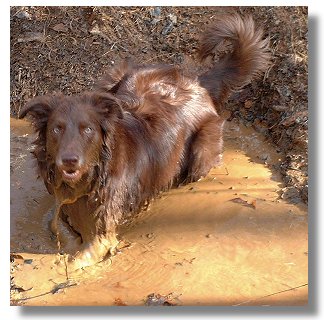 |
 |
Please take a moment to sign Kelley's Dreambook
Unfortunately, not long after getting Kelley we discovered she has CEA (Collie Eye Anomaly). Kelley's breeder didn't take the time to have her parents eyes checked before planning her litter. I had no recourse and was even looked down upon by her breeder for having Kelley's eyes checked at all.
Wheeee...I found a stick!!
CEA was first discovered in the Border Collie at a percentage of 7% in British dogs during 1984. This prompted the ISDS (International Sheepdog Society), to start screening for CEA along with CPRA (Central Progressive Retinal Atrophy). Australian Shepherds are also affected by CEA although no other breeds currently exhibit symptoms. One positive about CEA, it is not progressive and will not hinder the dog from enjoying a full life. It would go unnoticed without a qualified (Ophthalmologist) Vet's thorough examination. CEA has been recorded as producing six characteristic lesions, though not all of them will be present in just one dog.
CEA is a polygenic recessive trait and it is likely caused my several gene pairs. It doesn't follow the simple Mendelian ratios. Test breedings of affected to nonaffected have not proven successful in establishing whether an individual dog is clear. The best and ONLY method of preventing the propagation of affected Border Collies is to spay or neutered those who show as being positive for CEA. Then do NOT breed from either parent or littermates. You cannot tell who carries the genes or who does not. Copyright (c) 1999 by Janet E. Larson. 
Whaaat!?
Kelley
would like to introduce you to her Canadian
Need a little daily inspiration?
|
||||
 |